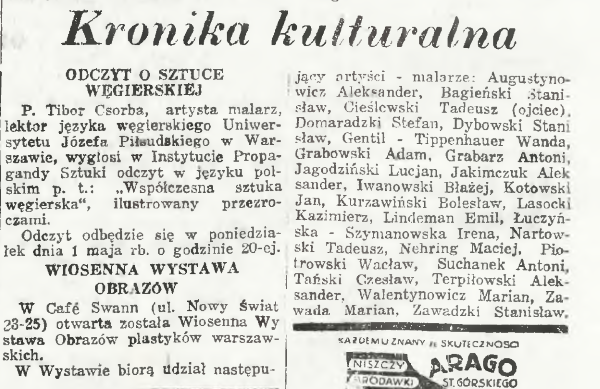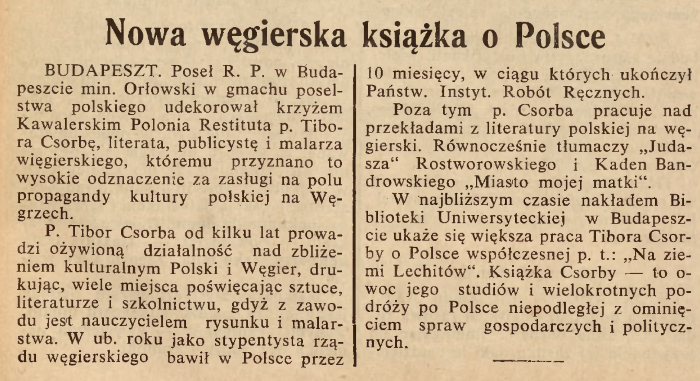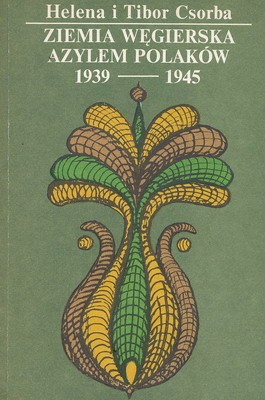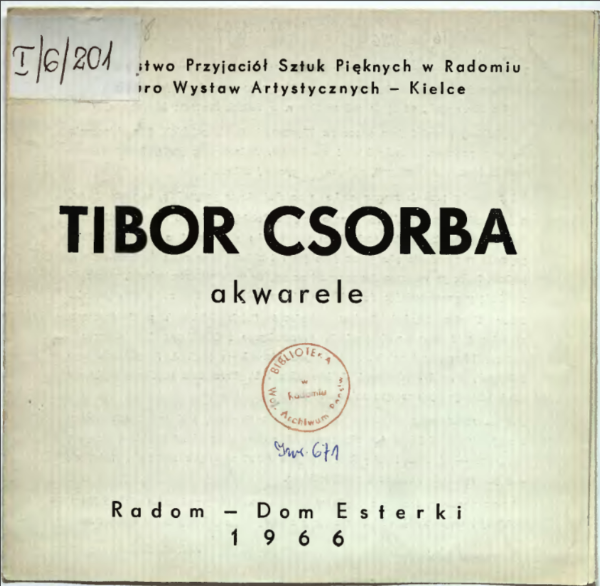Tibor Csorba is surely one of those people with an outstanding merit in popularizing Polish and Hungarian cultures. This talented watercolour painter, writer, translator of Polish and Hungarian literature, as well as a teacher, literary and art historian and publicist, has become permanently attached to Poland. Jan Sztaudynger wrote a limerick about him:
Tibor, you have shown us all,
That a Hungarian may be a Pole.
Tibor Csorba was born on 15 March 1906 in Szepesváralja (today in Slovakia). Since childhood his artistic talent made him stand out, which was one of the reasons for studying painting at the Academy of Fine Arts in Budapest. After graduating in 1929, Csorba delved further into art and pedagogy during his trips to London and Paris. His interests included the upbringing and education of school children - especially through art, so close to him. He was a drawing teacher at a school in Kiskunhalas at the time. During a pedagogical conference on modern education held in Cheltenham (UK), the idea of travelling to Poland was born. At the exhibition of works by young people from several countries accompanying the scientific event, Csorba's attention was drawn to the works of children from the banks of the Vistula. The young teacher wanted to learn about the Polish educational background behind the success of the young artists.

Interest in Polish culture
Tibor Csorba made his first trip to Poland in 1936. Slightly disappointed by the fact that painting classes in Poland were optional and not compulsory, Csorba was directed to a valued Polish engineer and educator, founder and head of the State Institute of Handicrafts (PIRR) - Władysław Przanowski. A year later, as a Hungarian government scholarship holder, Csorba spent 10 months in Poland, during which he became a PIRR student. He also made numerous research trips around the country, which he reported in the Hungarian press, including the Nemzeti Újság newspaper.
In 1938, Csorba began studying Polish philology at the Józef Piłsudski University in Warsaw (today the University of Warsaw). Under the direction of Prof. Julian Krzyżanowski (1892-1976) Csorba dealt with the topic of Polish-Hungarian relations in the 16th century literature. At the Warsaw university, Csorba was also a Hungarian language teacher. He also translated works by Rej, Kochanowski, Norwid and Sienkiewicz and published the results of his research in the field of literary studies in both popular and specialist press, including "A Hungarian poet at Polish courts in the 16th century". (Pamiętnik literacki, Lviv 1938).

Csorba, Hungarian troubadour at Polish courts in the sixteenth century, Nowiny codzienne 33/1938, p. 6.
Throughout that time, Csorba did not forget about his love of native Hungarian culture, which he popularized in texts printed in the Polish press, examples of which are "Contemporary Hungarian Art". (Rainbow 2/1938) or "Vigilia" (Rainbow 5/1938).
Another form of spreading the Magyar culture in Poland was giving lectures on Hungarian art. One of such lectures illustrated by the slides entitled "Contemporary Hungarian Art" took place at the Institute of Art Propaganda on May 1, 1939.

Note from T. Csorba's 1939 lecture, ABC Nowinki 125/1939.
In the run-up to the war, Csorba published Polonophilic texts in Hungary, in which he reported on his observations from repeated travels around the country, as well as popularized its culture, art and history, without regard to the politics and economic issues of the time. For his services to Poland, he was awarded the Polonia Restituta Knight's Cross by Minister Leon Orlowski. The ceremony took place in Budapest in 1938 and was connected with the publication of the book "In the land of the Lechians". A year later Csorba was awarded the Silver Laurel of the Polish Academy of Literature for "spreading love for Polish literature".

Note concerning the decoration of Tibor Csorba with the Knight's Cross Polonia Restituta, Nowiny Codzienne 221/1938.
The return from holidays spent in Hungary, planned for 1 September 1939, did not come to fruition - a flight on the Budapest-Warsaw route was redirected to Lviv. In the face of the USSR's invasion of Poland, Csorba decided to return to Budapest. At the beginning of January 1940 he managed to bring from Warsaw his fiancée Helena Millerówna - the heroine of the capital's defence decorated with the Cross of Valour, who brought with her pictures of the destroyed city.
Helping Polish refugees during World War II
Csorba and his wife Helena were intensely involved in helping Polish refugees in Hungary, working in the 9th Department of the Hungarian Interior Ministry. In the years 1939-1944 Csorba was a close associate of the then Minister of Refugees, head of the Refugee Office József Antall (1896-1974). Csorba cooperated in hiding and rescuing Poles. Moreover, he helped to set up Polish schools and place Poles at Hungarian universities, he also gave courses in Hungarian. During the war years his books were written: a textbook "Let's learn Hungarian" and a translation of traditional applications "Hungarian folk fairy tales", published in Budapest in 1940. He also published texts bringing Polish people closer to Hungarian culture, among others in the Polish weekly. Camp materials published in Budapest. He gave numerous lectures and workshops for Poles. In the 1970s József Antall issued a statement certifying that even after his arrest by the Gestapo in 1944, Csorba continued to help Polish refugees
.

Csorba T., Csorba H., Ziemia węgierska azlem Polaków 1939-1945, Warsaw 1985.
Years later, the Csorbas published together two books on the fate of Polish refugees in Hungary: "The fate of Polish youth in Hungary during World War II" (Warsaw 1981) and "Hungarian land as an asylum for Poles 1939-1945" (Warsaw 1985).
After the war
Helena and Tibor Csorba returned to Poland with the transport of repatriates in August 1945. Instead of returning to Warsaw, which was ruined after the uprising, they came to Krakow. There, Csorba became a lecturer in the Department of Hunting at the Jagiellonian University, where he worked until 1949. He organized the Hungarian Institute in Cracow and established the Polish-Hungarian Society. After the war, Csorba traveled with lectures and took part in literary meetings about culture, literature and art in Poland and Hungary. Special balls and theatrical shows of Hungarian plays were organized - often translated by Csorba himself. Together with his wife - a well-known medical and social welfare sociologist - they gave speeches describing the fate of Polish refugees in Hungary.

Echo Krakowa often published articles on Hungarian themes; no. 75/1947, p. 3.
In 1955, the Csorbas moved to a rebuilt Warsaw, with which they were bound for the rest of their lives. Around this time, Csorba completed work on the 80,000 entries in the Polish-Hungarian dictionary ("Lengyel-magyar szótár", Budapest 1958).
During numerous trips around Poland, Csorba had the opportunity to pursue almost all his interests. His trips were accompanied by reflections on literature, as well as sessions during which he had the opportunity to paint landscapes in his favourite watercolour technique. His extremely interesting and successful projects include the series of works collected in his folders, which are graphic records of his journey along the trail of important Polish and Hungarian figures. These works were a juxtaposition of historical accounts or descriptions of places known from literature with their contemporary state. This is how the "On Márton Csombor's Trail from Szepsi" of 1957, "On Maria Konopnicka's Trail" of 1961 and many others were created. A certain folder was related to Csorba's own experiences. During one of his first visits to Poland, Csorba took part in a course for foreigners (1937), during which he had the pleasure of being guided by one of the most famous Polish archaeologists of the time - Prof. Józef Kostrzewski, after he had just been discovered (1933), a settlement in Biskupin, famous throughout Europe. He described his impressions on this subject in the Hungarian press before the war. After 45 years, Tibor and his wife were invited back to Biskupin. The result of the stay were marker drawings depicting the settlement, which are currently in the collection of the State Archaeological Museum. Apart from cycles related to writers or historical figures, Csorba created works on regional themes, such as "My Warsaw". (1957-1970), or martyrological, such as "Sacra Polonica" (1976). The author has commented on his works and albums.
In 1962 Csorba was granted Polish citizenship. Since 1960, he has lectured on artistic education and upbringing through art at the Teacher's Study and the Architectural and Construction Technique in Warsaw.
Artist, writer and teacher
Throughout his life, Csorba has been a valued artist specialising primarily in watercolours, but also in texture compositions. His works were presented at individual and group exhibitions in Hungary, the United States or Poland. "Malarstwo" exhibition organized in Zachęta in 1981. Csorba's passions after the war still included translating both old and contemporary literature. He translated not only lyrical works, but also prose and dramas.

Tibor Csorba. Akwarele. Radom 1966.
Tibor Csorba. Watercolours Radom 1966.
The pre-war literature research undertaken by Csorba in Poland continued during the years of war turmoil at the Faculty of Philosophy of Budapest University. Their fruit was the dissertation "Batory as a humanist" (Báthory István, a humanist), published as a book in Budapest in 1944. It is difficult to count the journalistic and scientific texts on Polish and Hungarian culture and art that came out of Csorba's writing over several decades. Many of them are nowadays available in online digital repositories.
Csorba appreciated the importance of education and focused on educating young people through art. Two books are among the most important works left behind by this teacher highly regarded by other teachers and students: "Kształcenie a praca zawodowa nauczycieli wychowania plastycznego" (Warsaw 1967) and "O rysowaniu" (Warsaw 1980).
Tibor Csorba was a member of many prestigious associations, including Pen-Club, Association of Polish Writers, Association of Polish Artists and Designers, Association of Authors and Stage Composers. He died on 5 September 1985 during a short stay in Budapest. He was buried at the side of his beloved wife at the Powązki Military Cemetery in Warsaw.
.
Maria Jaworska
Z wykształcenia archeolog śródziemnomorski, absolwentka Instytutu Archeologii Uniwersytetu Warszawskiego. Doktorantka na Wydziale Historycznym Uniwersytetu Warszawskiego. Uczestniczka polskich badań archeologicznych, m.in. w Ptolemais (Libia), Novae (Bułgaria), Apsaros (Gruzja). Jedną z jej pasji jest popularyzacja historii.
Literature:
Csorba T., Opowieści piórem i pędzlem, Poznań niezapomniany, WTK 6/1975, p.12
Piotrowska D., Tibor Csorba i jego spotkania z Pałukami, Żnińskie Zeszyty Historyczne 14/1994, p. 17-39
http://pawelsliwko.blogspot.com/p/wychowanie-przez-sztuke.html
